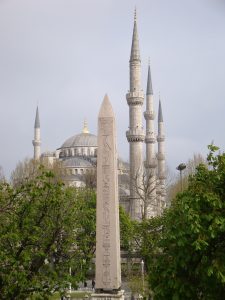Open daily outside prayer times. Closed Friday mornings for cleaning. Dress code requires both men and women to be modestly attired
Standing to one side of Sultanahmet‘s small park facing Ayasofya, İstanbul’s most famous mosque has to be the Sultanahmet Cami, better known to visitors as the Blue Mosque. With its extraordinary six minarets and its wonderful cascade of silvery domes and semi-domes, this is a building which completely dominates the skyline of Sarayburnu. It was the masterpiece of one Sedefkar Mehmed Ağa (c.1540-1617) , a student of Sinan’s, who designed it for the youthful Sultan Ahmed I between 1609 and 1616, reputedly bringing about the collapse of the İznik tile business in the process since the tile-makers, obliged to work for the sultan for minimal wages, soon made their escape to Kütahya.
The main entrance to the mosque is via the Hippodrome where you pass under an arch adorned with a chain and mount the steps to the courtyard. Most visitors, however, approach from the side facing Ayasofya. Whichever route you take you will be directed to an entrance for tourists where a strict dress code is enforced, with suitable clothing available for those who haven’t come prepared.
Inside the thing that will strike most visitors is how un-blue the mosque is for somewhere so routinely dubbed the Blue Mosque – Rüstem Paşa Cami, for example, is much more conspicuously blue. However, no one can fail to be impressed by the sheer size of the prayer hall with its soaring dome supported on four sturdy columns known as elephants’ feet. And inspection of the lower walls reveals an array of beautiful İznik tiles in which the blue rubs up against the red in a visual feast of ceramic flowers. Non-Muslims are no longer allowed to walk around the prayer area which means that they can’t examine the lovely marble mihrab more closely. However, they can still look at some of the wooden window shutters with their inlay of mother-of-pearl as well as admire the 250+ stained-glass windows.
Around the mosque
Of the külliye that once surrounded the mosque, the medrese (theological school) survives between the space filled with seating and the tomb of Sultan Ahmed although it’s not usually accessible to visitors. If you approach via the Hippodrome you will see beside the enclosing wall the small sibyan mekteb (primary school) that was also part of the complex and is also inaccessible. What was once a kitchen attached to the mosque has now been absorbed into the Rectorate of Marmara University which runs alone the far end of the Hippodrome.
Dead at one twenty-seven, Ahmed I was buried beside the medrese in a domed tomb the size of a small mosque together with his wife, Kösem, and his three sons by different women, Sultans Osman II and Murad IV, and Şehzade Beyazıd. Of these five, only Ahmed and Murad died natural deaths. The walls of the tomb are decorated with more İznik tiles.
Transport info
Sultanahmet Cami is most readily accessible via the T1 tram stop at Sultanahmet.
Nearby areas



